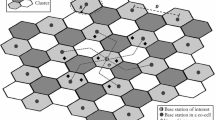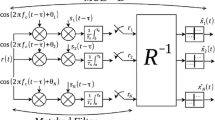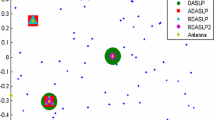Abstract
This paper considers the performance of adaptive interference cancellation applied to a CDMA microcellular environment, by employing a circular cell geometry and a closed form expression for the Bit Error Rate of a CDMA system with interference cancellation to analyze the effect of out-of-cell interference. Results are presented which indicate that out-of-cell interference will severely limit the benefits of interference cancellation in a multicellular system. Attempts to cancel all out-of-cell interference will further degrade performance. However, the use of selective interference cancellation in which only the strongest out-of-cell interferers are cancelled may result in significant performance enhancement. These results agree closely with those obtained using a hexagonal geometry.
Similar content being viewed by others
References
Klein S.Gilhousen et al., “On the capacity of a cellular CDMA system”, IEEE Trans. Veh. Tech., Vol. 40, No. 2, pp. 303–311, 1991.
S.Verdu, “Minimum probability of error for asynchronous Gaussian multiple access channels”, IEEE Trans. Info Theory, Vol. IT 32, No. 1, pp. 85–96, 1986.
R.Lupas and S.Verdu, “Linear multiuser detectors for synchronous code division multiple access channels”, IEEE Trans. Info Theory, Vol. 35, No. 1, pp. 123–136, 1989.
Z.Xie, C.K.Rushforth, R.T.Short, and T.K.Moon, “Joint signal detection and parameter estimation in multiuser communications”, IEEE Trans. Comm., Vol. 41, No. 7, pp. 1208–1215, 1993.
Andrew J.Viterbi, “Very low rate convolution codes for maximum theoretical performance of spread-spectrum multiple-access channels”, IEEE J. on Sel. Areas in Comm., Vol. 8, No. 4, pp. 641–649, 1990.
D.S.Chen and S.Roy, “An adaptive multiuser receiver for CDMA systems”, IEEE J. on Sel. Areas in Comm., Vol. 12, No. 5, pp. 808–816, 1994.
M.K.Varanasi and B.Aazhang, “Multistage detection in asynchronous code division multiple access communications,” IEEE Trans. Commun., Vol. 38, No. 4, pp. 509–519, 1990.
M.K.Varanasi and B.Aazhang, “Near optimum detection in synchronous code division multiple access system”, IEEE Trans. Comm., Vol. 39, No. 5, pp. 509–519, 1991.
D. Divsalar and M.K. Simon, “Improved CDMA performance using parallel interference cancellation,” IEEE Military Commun. Conf. (MILCOM '94), Fort Monmouth, NJ, pp. 911–917, 1994.
Ashish Kaul and Brian Woerner, “An analysis of adaptive multistage interference cancellation for CDMA,” Submitted to the IEEE Trans. Commun., 1994.
Ashish Kaul and Brian D. Woerner, “Analytical limits on the performance of adaptive multistage interference cancellation for CDMA,” IEEE Electronic Letters, accepted for publication, 1994.
R. Michael Buehrer and Brian D. Woerner, “Performance of CDMA multistage interference cancellation with phase and timing errors,” 1995 IEEE Universal Personal Commun. Conf. (UPC '95), Tokyo, Japan, 1995.
F.C. Cheng and J.M. Holtzman, “Effect of tracking errors on DS/CDMA successive interference cancellation,” GLOBECOM '94-Comm. Theory Mini-Conf., San Francisco, CA, pp. 166–170, 1994.
J.M. Holtzman, “Successive interference cancellation for direct-sequence code division multiple access,” IEEE Military Commun. Conf. (MILCOM '94), Fort Monmouth, NJ, pp. 997–1001, 1994.
T.Rappaport and L.Milstein, “Effects of radio propagation path loss on DS-CDMA cellular frequency reuse efficiency for the reverse channel”, IEEE Trans. Veh. Tech., Vol. 41, No. 3, pp. 231–242, 1992.
Joseph C.LibertiJr. and T.S.Rappaport, “Analytical results for capacity improvements in CDMA”, IEEE Trans. Veh. Tech., Vol. 43, No. 3, pp. 680–690, 1994.
William C.Y.Lee, Mobile Cellular Telecommunications Systems, McGraw-Hill: New York, 1989.
M.B.Pursley, “Performance evaluation for phase coded spread spectrum multiple access communication-Part I: System analysis,” IEEE Trans. Comm., Vol. COM 25, No. 8, pp. 795–799, 1977.
J.Lehnert and M.B.Pursley, “Error probabilities for binary direct sequence spread spectrum communications with random signature sequences”, IEEE Trans. Comm., Vol. COM 35, pp. 87–98, 1987.
Author information
Authors and Affiliations
Rights and permissions
About this article
Cite this article
Agashe, P., Woerner, B. Interference cancellation for a multicellular CDMA environment. Wireless Personal Communications 3, 1–15 (1996). https://doi.org/10.1007/BF00333920
Issue Date:
DOI: https://doi.org/10.1007/BF00333920




